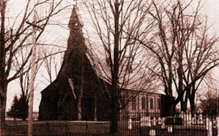In 1771, five years before our Founding Fathers declared our independence from British rule, a group of Swedish settlers living in the area we know now as Torresdale, weary of the five-mile trip on bad roads to Trinity Church, Oxford, decided they want their own church nearby. The rector of Trinity, the Rev. Dr. William Smith, obliged them by securing a little over an acre of land, on which a stone chapel was built in 1772-73. This was the founding of All Saints’ Episcopal Church, in what was then Lower Dublin Township.
They built the church on the King’s Highway, which had begun as a Native American footpath widened into a road through Royal Warrant by William Penn in 1686. Being the main north-south artery in those days, it was the road on which General Washington and his French ally Marshal Jean-Baptiste Donatien de Vimeur Compte de Rochambeau processed with their troops from Rhode Island to what became the victorious Battle of Yorktown, in Virginia. This road is now Frankford Avenue, a designated National Trail of the Washington-Rochambeau Revolutionary Route (W3R).
At the time of the founding of All Saints’, the area was mostly farm country. As the roads improved, making travel easier, the area grew in population and All Saints’ grew with it. It built an addition to the original church in 1811.
Although still a mission of Trinity, Oxford, All Saints’ was able in 1831 to establish its own chapel in nearby Holmesburg, soon to be named Emmanuel Church. All Saints’ grew stronger and was able to end its dependency on Trinity, Oxford in 1835, and went on to establish two more chapels, in Eddington and Church of the Redeemer, Andalusia, which is still active.
In the mid 1800s, large estates built as summer homes began appearing along the Delaware River. Many of new neighbors joined All Saints’, and soon the old church was too small. As the church added more land, the congregation planned a new building, money was raised, and the cornerstone was laid on August 31, 1854, with work being completed May 29, 1855. The architect was Frank Wills, an Englishman who studied at Oxford University and the Camden Cambridge Society and was the lead architect of the New York Ecclesiological Society. He designed the larger All Saints’ building in the Old English Chapel Gothic Style, which is the only surviving building designed by Wills in Pennsylvania.
In 1912, after a generous gift from parishioner Harriet Phillips Massey, the church built a school on its grounds. Called the Torresdale House, it was advertised to be the first fully equipped Montessori training school in the country. By the 1920’s, when the Montessori method of teaching became less popular, All Saints’ moved its school to larger quarters in Pen Ryn, an estate along the Delaware River, which also ran a camp there in the summer. The Torresdale House also became the Parish House to the church. In 1960, after the vestry decided to move the school from Pen Ryn back to All Saints’, they authorized a new school to be built behind the Parish House. After more than a half century it still serves the Torresdale community with Nursery, Pre-K, and Kindergarten classes.
The All Saints’ buildings sit on approximately 12 acres of ground surrounded by an 18th-century graveyard. It still preserves a bucolic look amid single-family home surrounding it. Twenty rectors have been called to All Saints’ since 1772. Four of them had remarkably long tenures and are buried in the graveyard; the Rev. Rush Eastman for 21 years; the Rev. Percy Brown for 37 years; and the Rev. Dr. Edward Chinn, for 43 years. The history of our burial ground reflects nearly two-and-a-half centuries of our country, beginning with the colonial period, with the first recorded burial in 1786, to the present day. It is the final resting place for many prominent Philadelphians, including business people, politicians, and about 160 veterans, three Confederate Civil War veterans, with others who served the country from the Revolutionary War to the War in Iraq.


